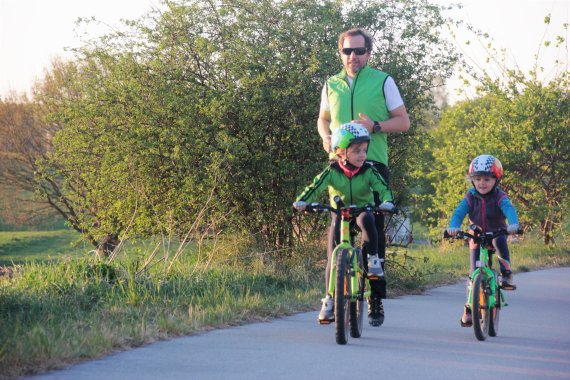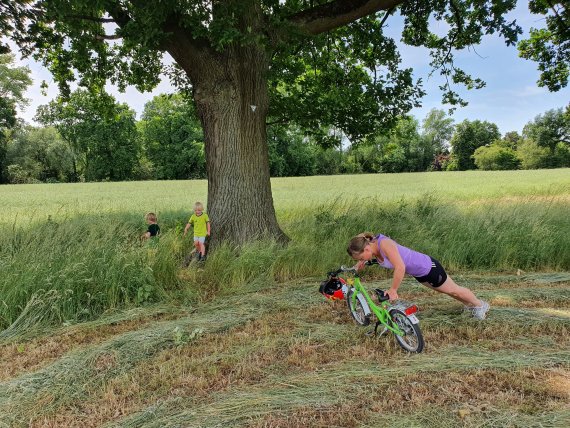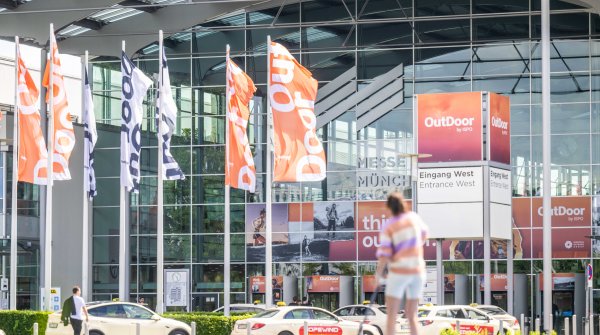
Dr. Susanne Kobel teaches at the Universitätklinikum Ulm, to which belongs an affiliated sports performance center. One of her main focuses is the support for development of physical activity for children of primary school age. The scientist believes that clear goals, variety, regularity, intensity and periods of rest are crucial for successful running training. Is this still possible with children?
ISPO.com: At what age does it make sense for children to accompany their parents during running training - and how?
Susanne Kobel: Children basically like to move around, a lot and for a long time. But in other forms of movement than adults. They train their endurance in a playful way - by racing or playing catch. They are less practised in running a certain distance without a break. The rule of thumb for children's running training is: "Run your age". This means: a seven-year-old should run loosely for seven minutes at a time, a ten-year-old for ten minutes. This makes it unrealistic for kids and parents to run together, at least if the adults are also to have a training success.But children can very well accompany their parents by bike, scooter or even inline skates, as soon as they have mastered the companions safely.

Put on your running shoes and off you go, the offspring rides peacefully with the bike on the parental side. Is it that easy?
Yes and no. Of course, not every child want to accompany their parents when running from the beginning. Every runner started small. This also applies to the children's abilities as "running companions". Basically (small) children like to accompany their parents, especially if it is something active.It is also clear that the needs of the kids have priority. This means above all: variety and short breaks! Children do not like straight lines between houses. They want different ground conditions, lots to see, smell and feel, and different tempos.
What are concrete motivators for kids to come along?
It is helpful to explain to the kids why parents like running, what their goals are and why they should come along. In this way they are introduced to an active lifestyle and quickly become "training partners".
Experience shows that children are also motivated by the following points:
- A wish list that can include music while running, or even an audio book, different routes or sections of routes, and things you want to find, which can then be "searched" during the tour.
- Children can be "training copilots" - with their own speedometer on their bike. The effect: They can see how fast they ride themselves or have ridden, how far they get and feel progression in the course of training.
- It makes sense to have a objective or partial goals that the children look forward to. Short races or sprints against the parents provide stimulating intermediate successes.
- During the classic endurance run in a relaxed training atmosphere, speed and load level should always be chosen in such a way that conversation is possible while doing it. Parents should take advantage of this. Most kids like to talk, especially in peace and quiet. In this way, topics may come up which the children are reluctant to talk about in front of their parents, but which are easier to talk about while cycling.
Which routes are conceivable with children and which trainings are suitable for parents in terms of efficiency and compatibility with children?
An endurance run up to 10 km and built-in intervals are absolutely possible even with children in pre-school age. Of course this has to be built up slowly. With a little practice, a lot can be done, for example the interval training - please be awre to do no more than once a week and only when the child is able to run over 5 km at a stretch. Also possible are short classic endurance runs, also supplemented by strength training suitable for children. And that's what it takes for parents to increase their fitness in a holistic, healthy and efficient way: Variety and balance.Only long endurance runs and very intensive training should be done without children. They are too strenuous, too long and too boring.
What makes interval training special and how can it be implemented practically with kids?
In contrast to the classic endurance run, interval training alternates fast, intensive training sections with active recovery phases, during which the run is relaxed and calm. The pace phases are defined by the runners themselves - either over distance or time. Practically implemented with children it goes from lantern to lantern, to the edge of the forest, up the mountain, to the next bench. The children can try to "beat" their parents for the foreseeable future, or stop the time of the adults. Often these distances can also be completed next to a playground where children can play during the intervals before continuing.
Of course, it is not possible with children to (always) "pull through" a classic curriculum interval training with a hardcore approach. That is not the point at all. The times for the sprints can be chosen individually and of course they still bring something. But please listen to your body, don't overdo it! For (ambitious) recreational runners, it is sufficient to build about four intervals into a 30-45 minute run. It is also important that you run 15 minutes loosely and that you don't put in the sprints at the end of a run - this is more damaging.
The body also needs a resting phase after intensive training: because that is exactly when the muscles are formed.
What are the benefits of sprints - what happens in the body?
By running consecutive sprints, the maximum oxygen intake and thus aerobic fitness is increased. More oxygen is available to the muscles and they can be exercised more intensively and longer. Over time, a higher basic pace is thus possible without slipping into the anaerobic zone. The body thus learns to deal with lactate and protons, which increases the running performance.In addition, after such intensive training the body burns significantly more energy to get into the rest phase.

Children like to stop every little while - how can you make good use of unexpected stops without losing the training effect?
Since a sensible endurance training should always be accompanied by a well-dosed strength training. Why not using the stop for strength exercises. They help to relieve knee and ankle joints, provide more balance and stability and thus prevent injuries. Muscle strengthening also helps against arthrosis, osteoporosis and muscle loss in old age - to name just a few positive effects.
Examples of suitable exercises are: Push-ups on a bench, "mountain climber" (supporting hands on a bench and with straight backs alternately and quickly pulling the knees towards the chest), alternating jumps (jumping quickly with one foot on the bench/stairway/trunk), or sit-ups.Ideal are 3 sets with 15-20 repetitions per exercise. In the beginning there should be a one minute break after each set. Later, more and more exercises can follow each other without a break. If the children want to join in, squats are a suitable exercise. Even the smallest children can do it. Very sporty parents sit the child on the straight (!) back during the exercise.
What positive effects does it have for the children to cycle next to their parents?
Children have good endurance in the aerobic area - and they are looking for role models. They actively experience their parents when running together. As studies show, this is one of the most important prerequisites for turning children into active people. This in turn is healthy and definitely worthy of support.
In addition to your own endurance, you also train other important points for your independence:
- Caution in (road) traffic: parents can draw attention to dangerous situations and rules.
- Assessing your own speed and strength: How far can I get at this pace? What speed do I have to choose to make it the whole distance?
- Reaction to different situations: How should I brake when it is wet or muddy? Can I drive as fast over a meadow hill as on the forest floor?
At what age does it make sense for children to run themselves? What do you need to consider?
From about five to eight years of age, children can be slowly introduced to running. Here the following applies: the parents teach the children to walk as an "investment". The running phases should playfully alternate different speeds and must be interrupted by breaks. This activates more muscle groups and fibres and prevents boredom.
In the pre-adolescent age (approx. 9-12 years) children grow very fast, including the leg bones. The bones are not very firm during this period and are susceptible to complaints, for example in the knees. These are forced by walking.
In puberty (13-14 years), the bones are not yet strong enough and the muscles are not yet able to absorb the constant strain of frequent long walks. More than 30-40 km per week - in trained young people - should not be exceeded. Therefore, speed can be trained at that age, which is also optimal for the training of parents.
Only from the age of 15 can young people really be involved in running training, then also several times a week, with endurance runs, interval programmes and also light weight training. The rule of thumb here should be that you should only run fast enough and for long enough to be able to have a conversation while running.
The appropriate heart rate for children running is 190 bpm. Always run carefully next to or with the child. If the face is red and a white triangle forms around the mouth and nose, the child is overexerted and urgently needs a break.
 OutDoor by ISPOOutDoor in transition
OutDoor by ISPOOutDoor in transition
- ISPO awards
- Mountain sports
- Bike
- Design
- Retail
- Fitness
- Health
- ISPO Job Market
- ISPO Munich
- ISPO Shanghai
- Running
- Brands
- Sustainability
- Olympia
- OutDoor
- Promotion
- Sports Business
- ISPO Textrends
- Triathlon
- Water sports
- Winter sports
- eSports
- SportsTech
- OutDoor by ISPO
- Heroes
- Transformation
- Sport Fashion
- Urban Culture
- Challenges of a CEO
- Trade fairs
- Sports
- Find the Balance
- Product reviews
- Newsletter Exclusive Area
- Magazine




